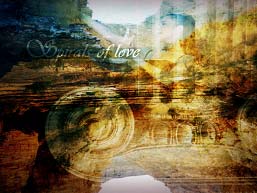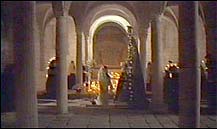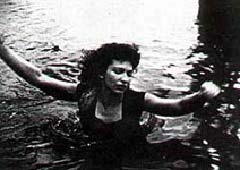SPIRITUAL
CINEMA
By
Lila Moore, PhD
 Since
its invention cinema was perceived as a kind of magic with
the capacity to transport our awareness to metaphysical realms.
In the cinema we sit in the dark whilst our gaze follows patterns
made of light. Images of concrete reality and fantasy are
projected on the screen like reflections of other worlds.
As viewers we accept the temporarily loss of physical reality
and in a state akin to dreaming, or occasionally trance, our
psyche blends images of reality and illusion until the real
and the unreal can not be differentiated. Since
its invention cinema was perceived as a kind of magic with
the capacity to transport our awareness to metaphysical realms.
In the cinema we sit in the dark whilst our gaze follows patterns
made of light. Images of concrete reality and fantasy are
projected on the screen like reflections of other worlds.
As viewers we accept the temporarily loss of physical reality
and in a state akin to dreaming, or occasionally trance, our
psyche blends images of reality and illusion until the real
and the unreal can not be differentiated.
Undoubtedly
we tend to react with real physical sensation to film images.
The connection between the pictures on the screen and the
mind is so intense that the impact is both physical and mental.
Brain research demonstrates that the human mind does not differentiate
between reality and fantasy, and film unlike any other art
has the power to enchant our awareness with intangible mirages.
The
origins of cinema can be found in pre-history and shamanic
art. The same magic thread runs through primordial rites and
the technologically advanced cinema of our time. The visionary
film producer and director Stephen Simon, co-founder of The
Spiritual Cinema Circle, describes filmmakers as shamans ‘who
combine stories and sounds and images to create celluloid
visions of reflected light that initiate us with the sacred
wisdom of our culture’.
In recent years a powerful wave of creativity and vision has
been unleashed building a new frontier of filmmaking and the
potential for a fresh and evolving cinematic genre. The spark
that ignited the fire that fuels this promising form of creativity
emerged from the cosmic depths of our intelligence and an
urgent need to heal the Earth and transform human consciousness.
In
2006 Lila Moore created a course for the Institute for
Spiritual Entertainment as a recommended Speaker of the
Spiritual Cinema Circle. The course was originally designed
to inspire and inform Spiritual Cinema Circle communities.
The course highlights a number of topics central to the
evolving genre:
Introduction:
The following Spiritual Cinema Circle course will take you
on a spiritual journey starting at the dawn of time and culminating
in an era where the realms of scientists and mystics merge
and transcend our experience of life on earth. The topics
will be demonstrated with screenings of film clips and shorts
issuing from the Spiritual Cinema Circle or recommended by
the Circle, and will be explored with audience participation.
Topic
A: Cinema of the Spirit
The
notion of filmmakers as magicians and shamans has its roots
in pre-history. Our ancestors did not make movies however
the art and magic of cinema began in caves hidden within the
ancient earth for thousands of years. Glimpsing the depths
of our collective unconscious and Dream Time we will explore
how cinema as a creative medium can connect us with, and manifest,
our deeply engraved spiritual nature, whilst throwing light
on the spiritual journey of our time.
Topic
B: Cinema of the Feminine Spirit
Long
before Niki Caro’s breathtaking Whale Rider, Maya Deren
directed At Land and Ritual in Transfigured Time unleashing
the language of the feminine body and psyche with the art
of cinema. The Spiritual Cinema Circle provides a unique platform
for women artists, authors and filmmakers by offering films
made by women that depict aspects of women’s lives and
spirituality rarely shown in mainstream cinema or television.
We will explore the new Screen Goddess, both as filmmaker
and performer, her boundless creativity, visual language,
healing powers and wisdom. Observing her reflecting the divine
female Creator, who gives form to ideas and connects spirit
with matter.
Topic
C: Cinema of Love and Transcendence
The
landmark film What Dreams May Come, the workshop film In To
See Me, the recent visionary film Conversations with God,
and many other precious films, reflect the desire of the Soul
to unite with its soul-mate and with a mysterious force of
eternal love that flows through the veins of Creation. We
will access the matrix and substance of innovative films inspired
by the power of love and the enigma of soul mates. We will
look into the mystical lore of soul mates, and the practice
of unconditional love in our daily lives, careers, creative
projects and relationships. This enlightening opportunity,
based entirely on knowledge and inspirational visions extracted
from films, will assist you to heal yourself and others, unleash
your creative spirit, enjoy the gifts of love, and help bring
peace and harmony to the world.”
Copyright, Lila Moore, 2006
ISE-LONDON
During
2006 Lila Moore and Heather Andrews Dobbs organised and presented
Spiritual Cinema Circle’s workshops inspired by films,
in central London. They offered a unique blend of film analysis
and discussion, spiritual psychology and transformative reflection.
The following article was inspired by the unique opportunity
to discuss women’s spirituality via a film experience.
It was published in the ISE Newsletter.
Artistic Movers
October 2006
Ise-global.org
Film review
Healing
Rhythms
By
Dr Lila Moore
The
Whisperer directed by Andrea Odezynska has a spellbinding
simplicity and raw beauty. The spontaneous camera movements
on location seem to follow Andrea’s vision and emotion
as she attempts to absorb, and connect with, the visible and
invisible realm she encounters in the village. Immersed in
a time capsule inside a rural village in Western Ukraine,
as a viewer, I felt transported to a timeless world where
witchcraft is a feminine art, and a way of knowing and healing
through nature. A world in which, nature and women co-operate
in rhythms so simple, so authentic and yet so powerful. The
personal aspect of the filmmaker’s journey to the Ukrainian
village reinforces the experience that the film generates.
Many of us talk about the divine feminine therefore it is
a delight to see aspects of her manifested in new films made
by women such as this one.
Since
the emergence of feminist film critique in the 1980s it became
apparent that the language of women filmmakers is often personal
and their stories are filled with intimate and detailed visual
observations. In The Whisperer we can see a similar attitude
to the portrayal of personal experience, and the importance
of featuring the visual and audio details that create the
magical environment and phenomenon. When Andrea arrives to
the village she is overwhelmed by what she sees saying: “I
was just really very moved… Everywhere you looked you
saw a beautiful frame…. I felt affected by the colours.
I felt affected by the absence of artificial light…
We were trying to capture the uncapturable…”
No
special effects or visual tricks are needed to express the
pain and depth of Andrea’s quest for healing. Nothing
can replace the authenticity of her tears. Her encounter with
Baba Anna, the local village healer, is stripped of all illusions
and yet filled with extraordinary charm. Although we find
out that Andrea’s healing is eventually made complete
in New-York with the aid of modern medicine, we feel that
the village healer opened the door for her healing to take
place. Providing Andrea with the energy to continue the healing
process and attain emotional fulfilment. The impression is
that the healer helped Andrea to connect with her feminine
self through water. Water has been the emblem and medium of
the divine feminine since the beginning of life on earth.
Although
The Whisperer is based on a personal depiction it highlights
the global tradition of women healers. It is a film that shows
us the inner workings of natural feminine magic and the healing
powers that women still possess in remote parts of the world.
In places in which the water can hear our voice, give shape
to the fire of passion, mirror the future, and answer the
longings of the heart.
ISE-London
In
2007 ISE-London will produce a number of events to celebrate
the emergence of the Divine Feminine in the evolving genre
of Spiritual Cinema. Income from tickets will be utilised
to support the expression of women’s creativity and
divinity in film.
For info on events and workshops contact: ise-london@blueplanetproductions.co.uk
In 2007 Lila Moore is a Guest Speaker in Tel Aviv SPIRITS,
International Spiritual Film Festival.
Tel
Aviv SPIRITS, International Spiritual Film Festival takes
place from April 26- April 28 2007 at Cinematheque Tel Aviv,
Israel's first art Cinema house.
In
London the special connection between cinema and the spirit
was originally explored in The Spiritual Cinema in St James
Church, Piccadilly. Established and led by filmmaker, and
Director of St Ethelburga’s Centre, Simon Keyes, Spiritual
Cinema commenced with homage to the films of Andrei Tarkovsky
who gave two lectures in St. James Piccadilly in 1984, and
his memorial service was held there two years later. His unforgettable
film Nostalgia was chosen to launch the first season of spiritual
cinema in September 2004.

“
I see it as my duty to stimulate reflection on what is essentially
human and eternal in each individual soul, and which all too
often a person will pass by, even though his fate lies in
his hands. He is too busy chasing after phantoms. In the end
everything can be reduced to the one simple element which
is all a person can count upon in his existence: the capacity
to love. The element can grow within the soul to become the
supreme factor which determines the meaning of a person’s
life. My function is to make whoever sees my films aware of
his need to love and to give his love, and aware that beauty
is summoning him”. Andrei Tarkovsky
In
the second season Lila Moore introduced the films of Maya
Deren with the screening of Ritual in Transfigured Time.
“Dr
Lila Moore has been involved in Spiritual Cinema at St James
Piccadilly for some time. She has spoken at several events,
for instance introducing films by Maya Deren, and led some
of the discussions that are a central aspect of the screenings.
We were particularly pleased to be able to screen her films
"Oasis - Experience Love and Gaia - Mysterious Rhythms"
which were well received and prompted a fascinating debate.
Her interest in the spiritual dimensions of cinema
is profound and inspiring”.
Simon Keyes
The
following article was written to support the screening of
Ritual in Transfigured Time
 Ritual
in Transfigured Time Ritual
in Transfigured Time
Director:
Maya Deren,
USA, 1946, 14 mins
By Lila Moore
Meshes,
Trances, Rituals and Meditations: Maya Deren created a series
of short films in the 1940s; Meshes of the Afternoon (1943),
At Land (1944), A Study in Choreography for the Camera (1945),
Ritual in Transfigured Time (1946) and Meditation on Violence
(1948). The films were realised alongside her attempts to
discover a new language integrating the formal aspects of
filmmaking, poetry and dance. The films form a body of work
that is usually discussed as a whole in order to be fully
appreciated. Each film is like a phase in a metaphysical journey,
a rite of passage leading to further mysteries.
“Each film was built as a chamber and became a corridor,
like a chain reaction. You know those puzzles games where
if you draw a continuous line from one point to another, consecutively
numbered, you end up with a picture? Well…I finally
drew these points and got a picture” (Maya Deren)
The
Ritual:
In Ritual Maya Deren explores the metaphysical dynamics of
a rite of passage, referring to ritualistic behaviour in an
anthropological sense, but locating the rite in a modern setting
where a widow undergoes a transformation through the dynamics
of ritualistic actions. Likewise tribal rituals in which the
participants are depersonalised through the use of masks and
movements, in Ritual the characters are merged with archetypal
concepts and images and their natural movements are formally
manipulated into, what Deren described as, “transcendental
tribal power towards the achievement of some extraordinary
grace”; the resurrection of the bride.
The
Dance:
“Was there anything like Choreography for the Camera
before Deren? Snyder: No, well I take it back, because we
don’t really know. There was another woman named Loie
Fuller, fifty years before Maya, who in her later years was
doing experimental films in Europe…” (Clark, Hodson
& Newman, 288)
Maya Deren pioneered a cinematic concept of dance choreography
based on the manipulation of movement, space and time. She
termed the new form ‘film-dance’ suggesting a
dance exclusively created by camera and editing. In Ritual
she produced the transcendental power of a ‘film- ritual’
through the filmic and choreographic manipulation of both
dance and non-dance elements.
A
Woman’s Rite:
When Maya Deren’s films were re-discovered by feminist
Filmmakers and theorists it became apparent that her exploration
of the female psyche, body and sexuality manifested in radical
concepts and depictions never seen before. Deren made her
films before any feminist critique of cinema or language existed.
She took her gender for granted exploring issues relating
to female identity and sexuality with total artistic liberty
and outside the limitations of Hollywood’s patriarchal
system.
Deren scripted and edited Ritual and performed the transitory
state of the protagonist sharing it with two other women.
Together the women are depersonalised and unified within a
larger archetypal notion of femininity. The film offers a
rich mosaic of mythic and symbolic imagery with many layers
of meanings ascribed to a sexual rite of passage as seen and
experienced by a woman.
Metaphysical
Experience:
The ability of the human mind to contemplate the physical
and material world, Maya Deren articulated, is a miraculous
ability that differentiates humans from other living creatures.
The metaphysical action of the human mind, she explained,
is as important as the material and physical activities of
the body. Stating, “my films are concerned with meanings,
ideas and concepts – not with matter”.
Ritual delivers the metaphysical process of transformation
through a ritualistic dance leading from the dark fears and
sufferings of a widow to the shining purity and ecstasy of
a bride. In technical film terms, at the end of the film the
widow in her black weeds of the first sequence becomes, by
use of a negative, the bride in her white gown.
Film,
Myth and Ritual:
In his book The Hero with a Thousands Faces (1949) Joseph
Campbell examines the decaying substance of ancient mythologies,
religions and nature-based rites, which no longer satisfies
the psyche and neuroses of modern people. Hopefully, Maya
Deren’s films, ideas, and depiction in Ritual can still
rekindle the interest in mythic and ritualistic expression
on screen, and in utilising 21st century film and video technology
to portray the contemporary heroine and hero by shifting the
attention to the spiritual quest of our time.
The
Future:
“As
we move forward in time and space we take with us the great
tradition and wisdom of cinema Masters who sensed the incredible
potential of the medium to become the vessel and the mirror
of the Soul. Cinema is primarily a visual medium and an art
form that can transcends our earth-bound ideas. We are in
the midst of a great cinematic adventure”. Lila Moore,
PhD
|

